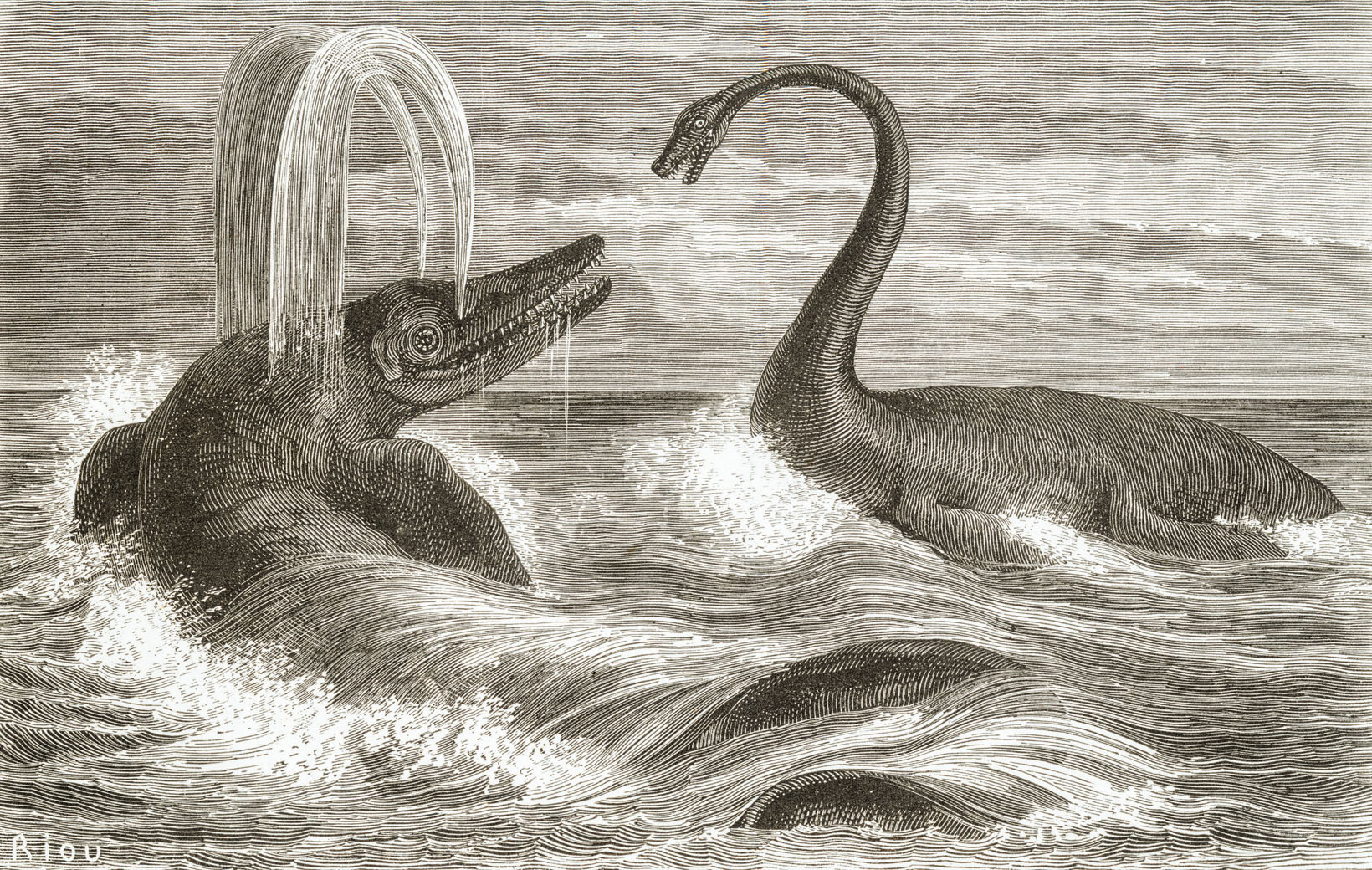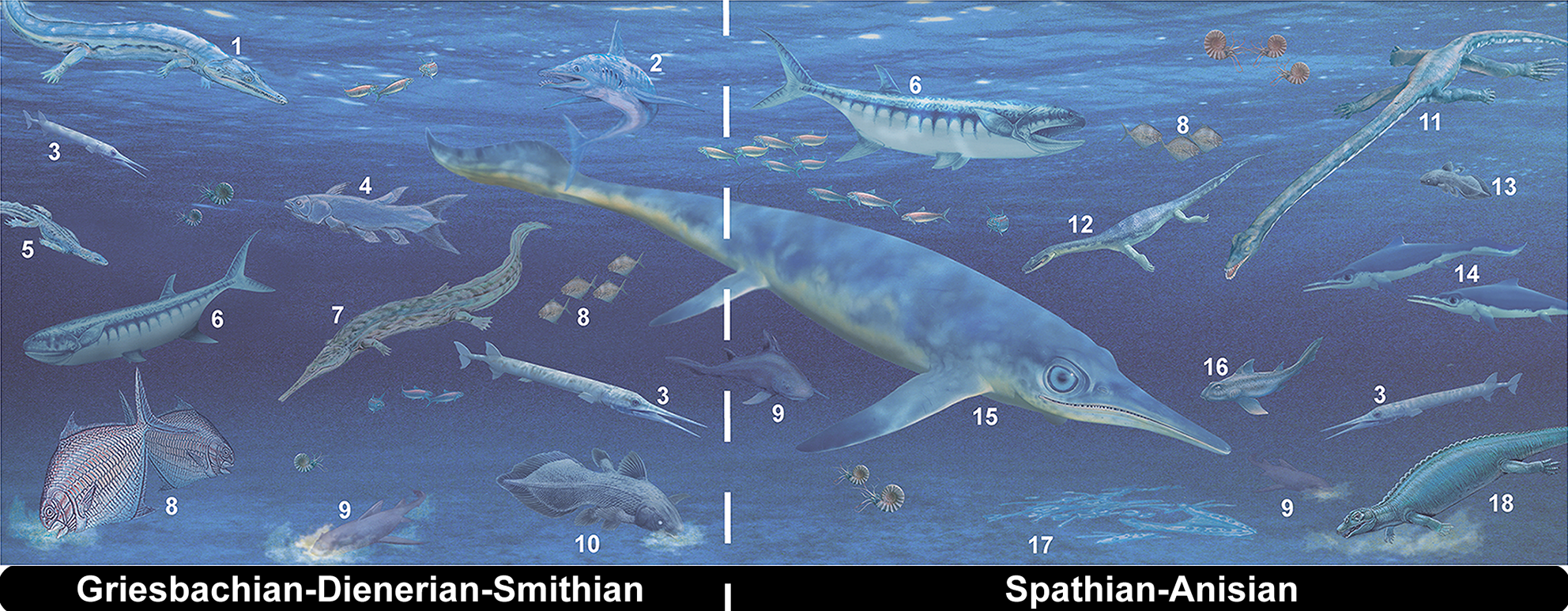|
Ichthyosauriformes
The Ichthyosauriformes are a group of marine reptiles, belonging to the Ichthyosauromorpha, that lived during the Mesozoic. The stem clade Ichthyosauriformes was in 2014 defined by Ryosuke Motani and colleagues as the group consisting of all ichthyosauromorphs that are more closely related to ''Ichthyosaurus communis'' than to ''Hupehsuchus nanchangensis''. Their synapomorphies include the possession of a long nasal bone, stretching to the front beyond the nostril; large scleral rings, filling the eye sockets; a narrow snout in top view; and converging digits with little space between them. The Ichthyosauriformes probably split off in the Early Triassic, about 250 million years ago; the last known forms lived in the middle Cretaceous. A basal ichthyosauriform is ''Cartorhynchus''; more derived species are part of the Ichthyopterygia which again include the Ichthyosauria. References Literature *Motani, R., Jiang, D.-Y., Chen, G.-B., Tintori, A., Rieppel, O., Ji, C., and Hua ... [...More Info...] [...Related Items...] OR: [Wikipedia] [Google] [Baidu] |
Cartorhynchus
''Cartorhynchus'' (meaning "shortened snout") is an extinct genus of basal (phylogenetics), early ichthyosauriformes, ichthyosauriform marine reptile that lived during the Early Triassic epoch (geology), epoch, about 248 million years ago. The genus contains a single species, ''Cartorhynchus lenticarpus'', named in 2014 by Ryosuke Motani and colleagues from a single nearly-complete skeleton found near Chaohu, Anhui Province, China. Along with its close relative ''Sclerocormus'', ''Cartorhynchus'' was part of a diversification of marine reptiles that occurred suddenly (over about one million years) during the Olenekian, Spathian stage (geology), substage, soon after the devastating Permian-Triassic extinction event, but they were subsequently driven to extinction by volcanism and sea level changes by the Middle Triassic. Measuring about long, ''Cartorhynchus'' was a small animal with a lizard-like body and a short torso; it probably swam in an eel-like manner at slow speeds. Its ... [...More Info...] [...Related Items...] OR: [Wikipedia] [Google] [Baidu] |
Ichthyosauromorpha
The Ichthyosauromorpha are an extinct clade of Mesozoic marine reptiles consisting of the Ichthyosauriformes and the Hupehsuchia. The node clade Ichthyosauromorpha was first defined by Ryosuke Motani ''et al.'' in 2014 as the group consisting of the last common ancestor of '' Ichthyosaurus communis'' and '' Hupehsuchus nanchangensis'', and all its descendants. Their synapomorphies, unique derived traits, include: the presence of an anterior flange on the humerus and radius; the lower end of the ulna being as wide as or wider than the upper end, the forelimb being as long as or longer than the hindlimb, the hand having at least three quarters of the length of the upper arm and lower arm combined, the fibula extending behind the level of the thighbone, and the transverse process of the vertebral neural arch being reduced or absent. The Ichthyosauromorpha were previously thought to have likely originated in China during the upper Lower Triassic period, about 248 million years ... [...More Info...] [...Related Items...] OR: [Wikipedia] [Google] [Baidu] |
Chaohusaurus
''Chaohusaurus'' is an extinct genus of basal ichthyosauriform, depending on definition possibly ichthyosaur, from the Early Triassic of Chaohu and Yuanan, China. Discovery and naming The type species ''Chaohusaurus geishanensis'' was named and described by Yang Zhongjian and Dong Zhiming in 1972, based on a fossil found during the construction of a railway. The generic name refers to lake Chao Hu. The specific name refers to the Geishan location. The holotype, IVPP V 4001, was uncovered in a layer of the Majianshan Limestone Formation dating from the Anisian. It consists of a partial skeleton, containing the skull and the front torso. In 1985 Chen Lizhu named two additional species based on fossils found in the same formation: ''Anhuisaurus chaoxianensis'' and ''Anhuisaurus faciles''. However, the generic name had already been preoccupied by the lizard '' Anhuisaurus'' Hou 1974. Therefore, ''Anhuisaurus'' Chen 1985 was in 1991 renamed into ''Chensaurus'' by Jean-Michel ... [...More Info...] [...Related Items...] OR: [Wikipedia] [Google] [Baidu] |
Omphalosauridae
Omphalosauridae is an extinct family (biology), family of Ichthyosauriformes known from the Early Triassic, Early to Late Triassic of Europe, North America, and Asia. References Ichthyosauriformes Early Triassic first appearances Middle Triassic extinctions Prehistoric reptile families {{Ichthyosaur-stub ... [...More Info...] [...Related Items...] OR: [Wikipedia] [Google] [Baidu] |
Utatsusaurus
''Utatsusaurus hataii'' is the earliest-known ichthyopterygian which lived in the Early Triassic period (c. 245–250 million years ago). It was nearly long with a slender body. The first specimen was found in Utatsu-cho (now part of Minamisanriku-cho), Miyagi Prefecture, Japan. It is the only described species in the genus ''Utatsusaurus'' and the only member of the family Utatsusauridae. The name ''Utatsusaurus'' was given after the city. The fossils have been found from the Early Triassic Osawa Formation of Miyagi Prefecture, Japan and British Columbia, Canada. ''Utatsusaurus'' is one of the most primitive grades of ichthyosaurs, a basal ichthyosaur. Description ''Utatsusaurus'' was a relatively small ichthyopterygian, measuring long and weighing . Unlike the more advanced ichthyosaurs, ''Utatsusaurus'' has no dorsal fin and has a broad skull. The snout gently tapers, compared to the more rounded one of more derived ichthyopterygians. The postorbital underlaps the elon ... [...More Info...] [...Related Items...] OR: [Wikipedia] [Google] [Baidu] |
Ichthyosauria
Ichthyosauria is an order of large extinct marine reptiles sometimes referred to as "ichthyosaurs", although the term is also used for wider clades in which the order resides. Ichthyosaurians thrived during much of the Mesozoic era; based on fossil evidence, they first appeared around 250 million years ago ( Ma) and at least one species survived until about 90 million years ago, into the Late Cretaceous. During the Early Triassic epoch, ichthyosaurs and other ichthyosauromorphs evolved from a group of unidentified land reptiles that returned to the sea, in a development similar to how the mammalian land-dwelling ancestors of modern-day dolphins and whales returned to the sea millions of years later, which they gradually came to resemble in a case of convergent evolution. Ichthyosaurians were particularly abundant in the Late Triassic and Early Jurassic periods, until they were replaced as the top aquatic predators by another marine reptilian group, the Plesiosauria, in t ... [...More Info...] [...Related Items...] OR: [Wikipedia] [Google] [Baidu] |
Parvinatator
''Parvinatator'', from Latin, “parvus” little and “natator” swimmer, is an extinct genus of small ichthyopterygian marine reptile that lived during the Early to Middle Triassic. Its fossils have been found in British Columbia, Canada.Nicholls, E. & Brinkman, D. (1995). A new ichthyosaur from the Triassic Sulphur Mountain formation of British Columbia. Sarjeant WAS (ed.): Vertebrate fossils and the evolution of scientific concepts: 521–535 London (Gordon & Breach). Geological information The only known Parvinatator fossil was located in an unknown horizon from the Sulfur Mountain Formation in a talus deposit, so its exact geological age is unknown. Best estimates place the fossil somewhere between the Olenekian and Ladinian age around 251-235 mya.Motani, R. (1999). Phylogeny of the Ichthyopterygia. Journal of Vertebrate Paleontology, 19:3, 473-496. Other small ichthyosaurs have been found nearby including Grippia, Utatsusaurus, and Phalarodon. Discovery ''Parvina ... [...More Info...] [...Related Items...] OR: [Wikipedia] [Google] [Baidu] |
Thaisaurus
''Thaisaurus'' is an extinct genus of ichthyopterygian marine reptile that lived during the Spathian (late Olenekian, Early Triassic). Fossils have been found in Thailand.New Material of ''Qianichtyosaurus'' Li, 1999 (Reptilia, Ichthyosauria) from the late Triassic of southern China, and Implications for the Distribution of Triassic Ichthyosaurs. Elizabeth L. Nicholls, Chen Wei, Makoto Manabe. Discovery The type specimen of ''Thaisaurus'' was discovered by Chongpan Chonglakmani on the hill Khao Thong, around Phattalung, Thailand. This specimen consists of a skull, partial vertebral series, and an incomplete fore- and hindlimb and was preserved in resistant Dolomite (rock), dolomite, alongside two other poorly preserved Fossil#Casts and molds, natural molds of other specimens. The type specimen was subsequently extracted in 1988 by a joint paleontological expedention from Thailand and France. The specimen is housed in the Department of Mineral Resources (Thailand), Department of M ... [...More Info...] [...Related Items...] OR: [Wikipedia] [Google] [Baidu] |
Gulosaurus
''Gulosaurus'' is an extinct genus of basal grippidian ichthyopterygian known from the Early Triassic Vega-Phroso Siltstone Member of the Sulphur Mountain Formation of east-central British Columbia, Canada. ''Gulosaurus'' was first named by Robin S. Cuthbertson, Anthony P. Russell and Jason S. Anderson in 2013 and the type species is ''Gulosaurus helmi''. The name means 'Helm's wolverine lizard' and refers to the Wolverine Nordic and Mountain Society, who maintain the area around Wapiti Lake where it was found, and to Dr Charles Helm, who is a leading paleontologist around this same area. Originally ''Gulosaurus'' was thought to be either '' Grippia longirostris'' or '' Parvinatator wapitiensis,'' but as the fossil was incomplete it was uncertain which. In 2013, the other half of the fossil, including its skull, was discovered and this proved it to be a new species entirely, closely related to ''Grippia'' and very similar. Features Overall, ''Gulosaurus'' was similar t ... [...More Info...] [...Related Items...] OR: [Wikipedia] [Google] [Baidu] |
Hupehsuchus Nanchangensis
''Hupehsuchus'' is an extinct genus of small marine reptiles, about 1 m (3 ft) long, found in the area of Hubei in China. This marine reptile lived in the Olenekian stage of the Early Triassic period. It was probably a filter feeder, like modern baleen whales. Description ''Hupehsuchus'' was similar to its close relative, '' Nanchangosaurus'', but differed from it in a number of ways. For example, ''Hupehsuchus'' had heavier armor on its back than ''Nanchangosaurus'', and its back spines were more finely divided, giving it a more crocodile-like appearance than ''Nanchangosaurus''. It had a thin, long snout like a gharial, river dolphin, or ichthyosaur, which it probably used to snag fish or probe for aquatic invertebrates. A 2023 study suggests, on the basis of cranial anatomy paralleling that of baleen whales Baleen whales (), also known as whalebone whales, are marine mammals of the order (biology), parvorder Mysticeti in the infraorder Cetacea (whales, dolphi ... [...More Info...] [...Related Items...] OR: [Wikipedia] [Google] [Baidu] |
Olenekian First Appearances
In the geologic timescale, the Olenekian is an age in the Early Triassic epoch; in chronostratigraphy, it is a stage in the Lower Triassic series. It spans the time between Ma and Ma (million years ago). The Olenekian is sometimes divided into the Smithian and the Spathian subages or substages. The Olenekian follows the Induan and is followed by the Anisian (Middle Triassic). The Olenekian saw the deposition of a large part of the Buntsandstein in Europe. The Olenekian is roughly coeval with the regional Yongningzhenian Stage used in China. Stratigraphic definitions The Olenekian Stage was introduced into scientific literature by Russian stratigraphers in 1956. The stage is named after Olenëk in Siberia. Before the subdivision in Olenekian and Induan became established, both stages formed the Scythian Stage, which has since disappeared from the official timescale. The base of the Olenekian is at the lowest occurrence of the ammonoids '' Hedenstroemia'' or '' Meekoceras graci ... [...More Info...] [...Related Items...] OR: [Wikipedia] [Google] [Baidu] |
Mesozoic Reptiles
The Mesozoic Era is the era of Earth's geological history, lasting from about , comprising the Triassic, Jurassic and Cretaceous Periods. It is characterized by the dominance of archosaurian reptiles such as the dinosaurs, and of gymnosperms such as cycads, ginkgoaceae and araucarian conifers; a hot greenhouse climate; and the tectonic break-up of Pangaea. The Mesozoic is the middle of the three eras since complex life evolved: the Paleozoic, the Mesozoic, and the Cenozoic. The era began in the wake of the Permian–Triassic extinction event, the largest mass extinction in Earth's history, and ended with the Cretaceous–Paleogene extinction event, another mass extinction whose victims included the non-avian dinosaurs, pterosaurs, mosasaurs, and plesiosaurs. The Mesozoic was a time of significant tectonic, climatic, and evolutionary activity. The supercontinent Pangaea began to break apart into separate landmasses. The climate of the Mesozoic was varied, alternating between ... [...More Info...] [...Related Items...] OR: [Wikipedia] [Google] [Baidu] |







